If you’ve ever dealt with emergency leaks in your fish tank, then you know how frustrating it can be. It takes a lot of time and effort trying to find an effective solution, especially if you have a huge fish tank. There are also some fish tank sealant products that actually damage your aquarium, so it’s best to find a more reliable one.
In this article, we’ll cover everything from what makes a good sealant for your aquarium, to helpful tips and tricks on applying aquarium-safe silicone. Then, we’ll review several excellent options for fish tank sealant. Once you’ve finished reading, you’ll have everything you need to choose the best aquarium-safe silicone for your tank.
Comparison Table of The 6 Best Aquarium Safe Silicone
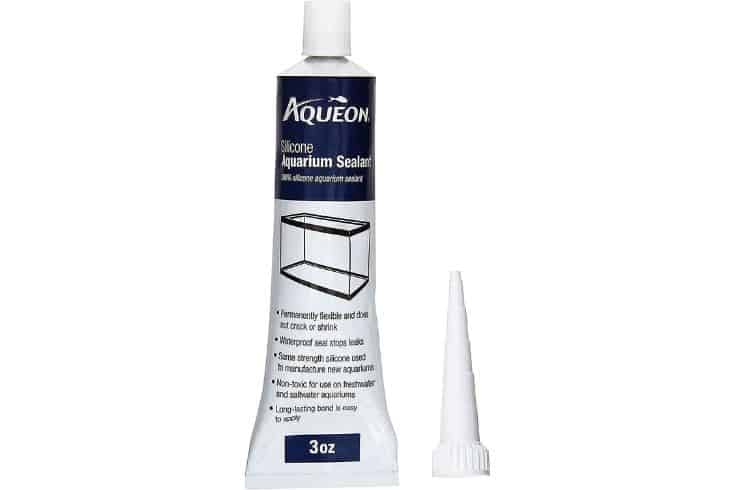
BRAND
Aqueon Silicone Aquarium Sealant
DETAILS
- Comes in a 3 oz tube
- Waterproof and non-toxic
- Colorless finish
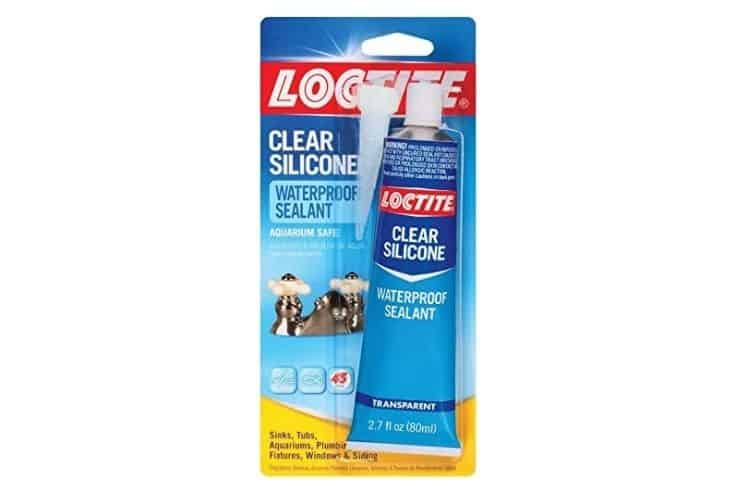
Loctite Clear Silicone Waterproof Sealant
- Clear sealant
- Made of aquarium-safe 100% silicone
- For use in aquariums up to 30 gallons large
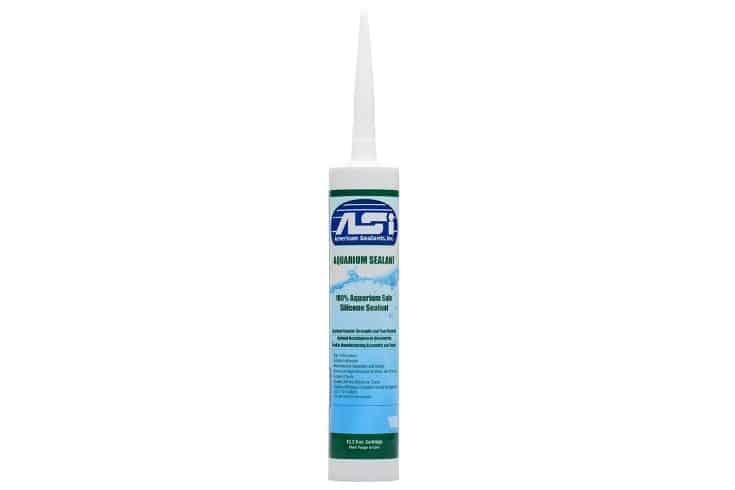
ASI Clear Aquarium Silicone Sealant
- Primerless application
- Clear sealant
- USDA-certified fish safe
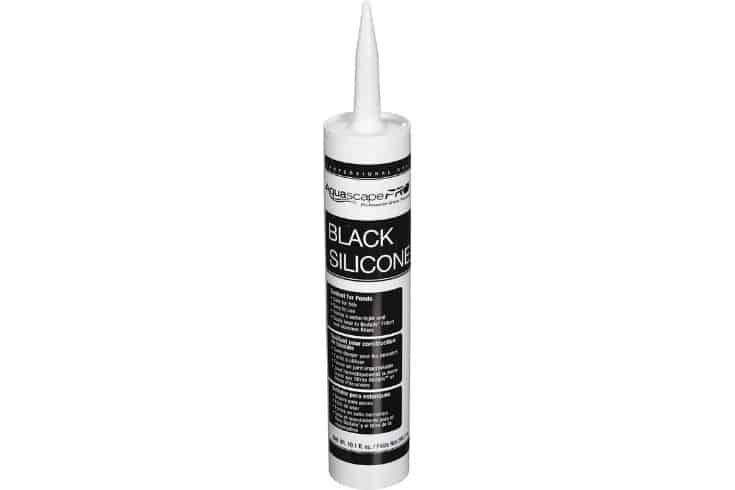
Aquascape Black Silicone Sealant
- Opaque, dark finish
- Versatile
- Average cure time
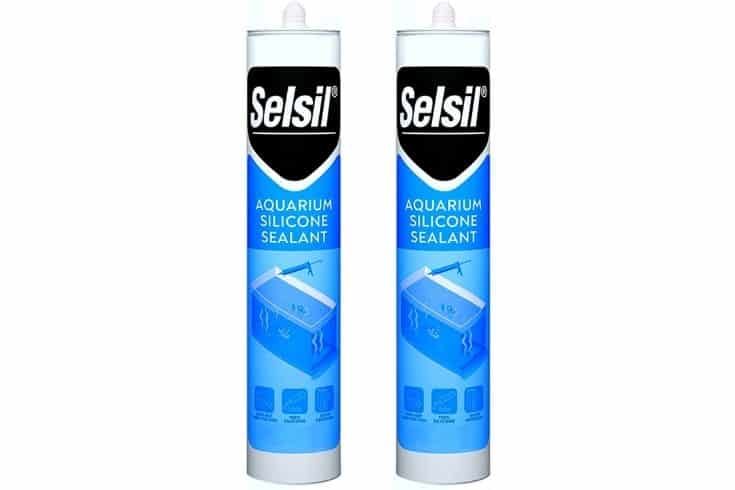
SELSIL Aquarium Silicone Sealant
- Transparent sealant
- Can be used on a wide range of materials
- High tensile strength
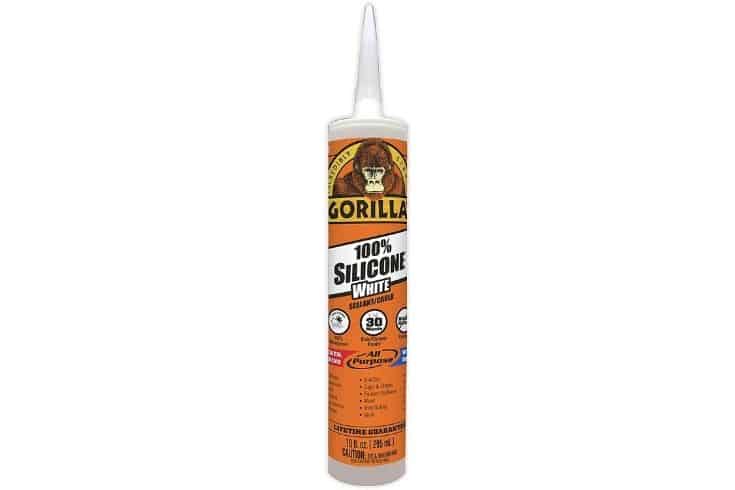
Gorilla White Silicone Sealant
- Semi-opaque sealant
- Rated for use in marine settings
- Mold and mildew protection
What Is Aquarium-Safe Silicone?
Before we or any other website can recommend a specific or general product, it’s essential that you know what aquarium-safe silicone is.
Like most types of silicone, fish tank sealants can be made from different materials. Some are by-products from the petroleum industry while others are created from plant products. Most of these materials do not harm the seals of your fish tank.
However, some of these materials contain chemicals that can harm or kill aquatic life over time. For this reason, the best aquarium-safe silicone is one that’s made from plant oils and minerals. Silicone types like Dow Corning 732 are excellent options for your tank; they’re durable yet won’t release harmful chemicals over time.
What To Look For In Aquarium Safe Silicone
Once you’ve established what to look for in aquarium-safe silicone, it’s much easier to choose the best product for your tank. Here are the most important qualities to consider:
Ingredients
Aquarium-grade silicones are typically made out of 100% non-toxic silicone that is safe for fish and aquatic plants. This means that the sealant won’t release harmful chemicals into your aquarium over time, such as lead or mercury. Regular silicone sealers you find in stores may contain harmful chemicals, so always read the label before buying.

In addition, any type of silicone that emits airborne chemicals can cause damage to your aquarium’s glass. Though many brands of aquarium silicone sealant come with a strong smell, the scent should only linger for a few hours. If you notice that the smell is still around after 24 hours, it’s likely that your sealant contains harmful chemicals like mercury or lead.
Finally, the safest silicones are those that claim to be 100% solvent-free. This means that they shouldn’t utilize chemicals like benzene or hexane, which can cause damage over time. If you intend to use the sealant in saltwater tanks, then it would be helpful to find a product that says “saltwater safe” as well.
Viscosity
The ease of application of your sealant is very important. If it’s difficult to spread, then you’ll waste a lot of the product and time just trying to cover the surfaces of your tank. On the other hand, silicone that’s neither too thick nor too thin will make the application simple and fuss-free for you. Generally speaking, silicone that’s slightly thinner than toothpaste is the best option for most silicone repairs.
Additionally, the nature of your repair job may require sealants of different consistencies for accurate application. For instance, a corner seam repair will require a thicker sealant to form a protective seal that lasts. This means you would be better off choosing a thicker product for this type of job. On the other end, thinner sealants are ideal for repairs that require less coverage.
Beginners who are repairing a leak with silicone for the first time should always purchase a sealant that has above-average viscosity. This will make the application process easier, as you won’t have to deal with drips or uneven surfaces. If you intend to use a caulking gun, viscosity also becomes more important because you’ll need a thicker product for precise gluing. Using the right kind of silicone for the job will make your repairs quicker and easier.
Durability
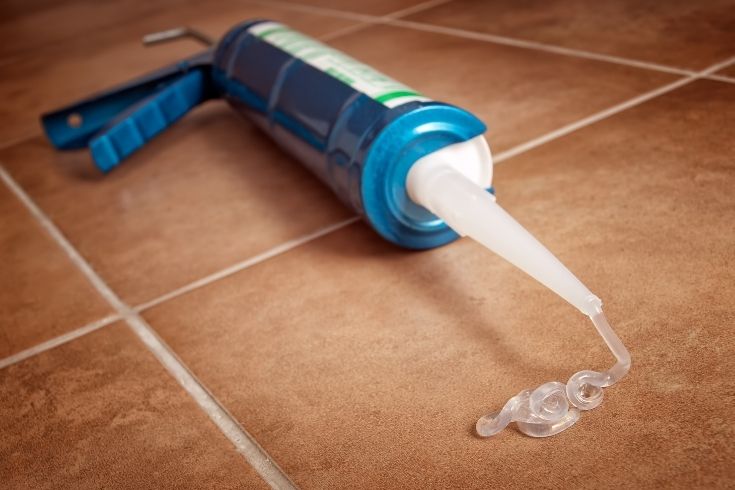
A reliable silicone sealant will make a world of difference to the shelf life and durability of your aquarium. The best options will form strong bonds that last over long periods of time – and in many cases, form a permanent seal. This means that you’ll never have to worry about leaks or cracks in your tank glass once the seal has been applied.
Most aquarium-safe brands of silicone also guarantee that their sealant is capable of withstanding extreme temperatures and prolonged exposure to UV radiation. This ability to form durable bonds in all types of weather conditions makes them highly reliable for many tank repairs. Things like broken glass and hairline cracks can often be repaired with a quality aquarium silicone, which can help you save money by fixing leaks instead of replacing your entire tank.
The final element of a solid bond is how well the sealant stands up to fish and water contact. A good product bonds to glass and creates a tight seal that can hold its own under continuous immersion in water. Not only will it last longer than inferior sealant, but your fish won’t be in danger of getting stuck behind the glass or jumping through newly formed cracks.
Versatility
Silicone sealants have a broad range of applications, but only the highest quality products can be used reliably on aquarium glass, particularly as part of larger tanks. A versatile product bonds with glass, but also has an impressive grip on a wide variety of materials, such as stainless steel, plastic, and ceramics. When you think about the tank as a whole, these elements become more important.
For example, you may be at the point of needing to replace your old aquarium glass with new materials like tempered glass, fiberglass, or acrylic. Even though silicone is safe for most fish and won’t pose any long-term damage, a product with a limited array of applications will only make these replacements harder. A versatile silicone sealant will bond with any type of glass, meaning that you can repair cracks and breaks with ease regardless of their location or size.

A more rarely considered aspect of versatility lies in the color and finish of the sealant itself. Black silicone is usually the preferred choice for most aquarium repairs because a black seal is less noticeable on the glass and doesn’t distract from your fish. If black color is a problem for your tank, choose a product with a transparent finish to blend in seamlessly with the glass’s appearance. Either way, it’s essential that you choose a sealant that won’t ruin your tank’s aesthetic.
Price Point
Last but not least, the price point of the sealant you choose is an important factor to take into consideration. A tube of silicone can easily cost anywhere from a few dollars to over a hundred, depending on the brand and product type. This means that every layer of silicone you add will increase your expenses. For that reason, it’s vital to pick something that comes at an affordable price, yet isn’t so cheap that it will crack over time.
In general, a tube of aquarium-safe silicone can last you anywhere from two to six months, depending on the frequency and size of your tank’s repairs. A larger tube will typically cost less per gram, but a smaller tube or a more convenient size may be worth the extra money when you consider how often it’s necessary to use the sealant.
When looking at all these factors, it’s best to purchase your sealant from a reputable brand known for durability and quality workmanship. Most of the leading manufacturers produce aquarium silicone products that can withstand any type of tank repair, without the need for additional reinforcement. At the end of the day, the goal is to pick something affordable but effective, with the ability to bond reliably with aquarium glass for maximum durability.
Tips On Using Silicone Sealants Correctly
General aquarium silicone sealants are very easy to use when they’re properly applied, but that doesn’t mean that you can just slap some on and expect it to work. Like any type of adhesive, the best results come from careful preparation, cleanliness, and attention to detail. Here are some quick tips to help you get the most out of your sealant:
- A textured sponge will help pick up any excess silicone that may drip over the edge of your aquarium.
- A fish tank’s glass must be completely dry, otherwise you risk trapping water during the curing process and creating new cracks. If there are small particles left on the exterior of your tank, use a clean rag to wipe them off.
- Cheap caulking guns are often prone to leakage, clogging, and pinching the silicone tube. It’s better to go with a high-quality product that will ensure an even seal every time.
- Silicone is typically applied in thin layers to create an invisible repair. Your first pass should be about ⅛ inch thick, after which you should wait 15 hours between application passes.
- Though silicone is widely considered to be the safest adhesive on the market, it can be the wrong choice for certain materials. Acrylic surfaces like plastic filters and lenses can be damaged when exposed to silicone, so avoid using silicone on acrylic fish tanks.
- A utility knife can be useful for cutting silicone tubing and cleaning up excess material around the edges of your aquarium.
- One of the main cons of silicone sealants is that they take a long time to cure. If possible, you should apply your sealant in a room with low humidity and let it set overnight, so it’s ready for use the next day.
Generally speaking, it’s a good idea to give your sealant a full 24 hours of curing time before putting water back in your tank. If possible, try to remove all the fish before you start a repair job.
Best Aquarium-Safe Silicone – Top Recommendations
Now that you know what to look for, let’s take a closer look at five of the best aquarium sealants on the market. Each is uniquely suited for different types of tanks and repairs, so it’s important to explore all your options before settling on a product:
1. Aqueon Silicone Aquarium Sealant

- Comes in a 3 oz tube
- Waterproof and non-toxic
- Colorless finish
First on our list is this Aqueon silicone sealant that’s going to be a great choice if you’re looking for a flexible, durable, and affordable sealant that will keep your tank watertight. It’s one of our favorite aquarium-safe silicone sealants out there because it works very well at preventing leaks and cracks from forming in your tank. It also comes in a 3 oz tube that’s perfect for creating an airtight seal around smaller leaks and cracks.
Aqueon is an excellent sealant for people who want something that’s highly durable but easy to apply. You’ll find it easy enough to use, whether you choose to apply it with your finger or a rubber squeegee. It boasts great adhesion on glass, which is good if you’re trying to prevent leaks in the long term. If you need a sealant that’s highly flexible, this could be an excellent choice for your tank.
However, one thing to keep in mind with silicone sealants is that they require sufficient curing time in order to maintain their flexibility. This sealant only takes about 4 hours before it’s completely cured, which is why if you do end up using this product you should apply it at least that long before putting water in your tank. Once it has a chance to cure, it can form a very flexible and durable bond with your glass.
PROS
- Comes in a conveniently sized tube
- Great glass adhesion
- Quick cure time
CONS
- Needs to be used quickly or it will dry up
- Has a strong smell
2. Loctite Clear Silicone Waterproof Sealant

- Clear sealant
- Made of aquarium-safe 100% silicone
- For use in aquariums up to 30 gallons large
Of the many brands advertising waterproof silicone, Loctite is one of the most well-known. This product has received many positive reviews, and for good reason: it’s designed to be used by virtually anyone and will provide strong protection against leaks and cracks in your aquarium glass. It’s also a clear-colored silicone sealant that looks very nice and won’t detract from the aesthetics of your tank
The main reason why this is an extremely popular brand of silicone amongst aquarists isn’t just because it’s very easy to use; rather, it’s also incredibly strong and is designed to withstand constant submersion in water without deteriorating or losing its waterproofing properties. Made of aquarium-safe 100% silicone, it’s guaranteed to be safe for your aquarium.
One thing to note about using the Loctite is that it’s not designed to be used in aquariums larger than 30 gallons, or with more than 18 inches of water. It’s important to read the instructions carefully so that you can determine if it’s a good match for your tank. If you do, it’s easy to apply, and you’ll find that it works great for preventing leaks in your tank.
PROS
- Great water resistance
- Long-lasting protection against leaks and cracks
- Non-toxic once cured
CONS
- Doesn’t work well on larger tanks
- Can be difficult to find
3. ASI Clear Aquarium Silicone Sealant

- Primerless application
- Clear sealant
- USDA-certified fish safe
This brand of silicone sealant is designed with aquarium use in mind. It provides an easy, primerless application so that you can get on with your DIY project as quickly as possible. This product is equipped with a rubber squeegee for precision sealing, and it has a high-tack adhesive that can be removed with a damp cloth. Thereafter, the adhesive becomes non-toxic and completely safe for your aquarium.
One cool thing about this product is that it is specifically formulated for aquariums, and is USDA-certified as completely fish-safe. Whether you intend to use it in a freshwater or saltwater tank, you can be confident that it’s not going to cause any damage. When it comes to durability, this silicone provides strong adhesion to glass and can last for years.
Though this sealant may cost a little more than other brands, you get more bang for your buck as the tube contains 10.2 ounces of silicone, which is enough to seal even the largest tanks in your fish room. Just be sure to use it in a well-ventilated room, as it does have a strong, vinegar-like odor that can be off-putting to some. That being said, it’s a great product that will provide you with strong protection against leaks and cracks in your aquarium glass.
PROS
- USDA-certified as completely fish-safe
- Strong adhesive for sealing aquarium glass
- Good value for money
CONS
- Vinegar smell can be unpleasant
- Need to use in a well-ventilated room
4. Aquascape Black Silicone Sealant

- Opaque, dark finish
- Versatile
- Average cure time
Does your DIY project call for a black aquarium-safe silicone sealant? Aquascape is the choice of silicone for many aquarists in need of a black sealant because it’s designed specifically for maximum adhesion to glass surfaces. It leaves no residue behind, and it provides protection against water leakage in both fresh and saltwater aquariums.
This is a non-toxic black sealant that will not cause any damage to your fish or plants due to its non-toxic formula. Like most aquarium brands, Aquascape goes the extra mile to ensure that its products are 100% safe for your aquarium, so you can use them without the fear of causing any harm to your fish.
Furthermore, Aquascape black silicone sealant is incredibly flexible in order to give you more leeway in terms of achieving a perfect fit when sealing up cracks or gaps. You’ll also find that this product is equipped with a long-lasting adhesive that helps to eliminate air pockets between the glass and silicone, which can weaken the overall seal.
PROS
- Specifically designed for aquarium use
- Gives a long-lasting watertight seal
- Non-toxic formula is safe for fish and plants
CONS
- No media trays
- Not self-priming
- Replacement parts can be pricey
5. SELSIL Aquarium Silicone Sealant

- Transparent sealant
- Can be used on a wide range of materials
- High tensile strength
From SELSIL comes a versatile aquarium product that can be used to seal up any cracks or leaks in the glass of your tank. This silicone is transparent and flexible for easy application, and won’t leave behind any residue after you’re finished using it. Whether you intend to use it on marble, glass, concrete, or aluminum, you can be confident in its ability to prevent leaks and hold up against heavy pressure.
This aquarium silicone sealant is 100% waterproof, and it provides a good adhesive that won’t cause the glass to lift or bend out of shape even if you apply too much of it. The flexible sealant will stretch instead of break when faced with extreme water pressure from outside of the tank, and it is clear enough that you can use it to cover up unsightly cracks in your aquarium without disrupting the look of your fish room.
Like most silicone sealants, the SELSIL shouldn’t be used with acrylic surfaces. However, it’s a great choice for any aquarium-related projects that require a clear sealant. As an added bonus, it also dries quickly to prevent delays in your work.
PROS
- Strong adhesive that won’t crack under pressure
- Clear formula won’t alter the look of your aquarium
- Flexible for easy application around corners and curves
CONS
- Tricky to remove excess sealant from glass surfaces
- Not suitable for use with acrylic surfaces
6. Gorilla White Silicone Sealant

- Transparent sealant
- Can be used on a wide range of materials
- High tensile strength
If you’re looking for a way to cover up unsightly cracks or leaks in your aquarium that won’t alter the look of your fish room, then Gorilla White Silicone Sealant is a good option. This sealant provides a high-lasting watertight barrier once it has been applied to glass surfaces, and it dries quickly to prevent any delays in your work.
This product is 100% waterproof, and the flexible sealant will stretch instead of break when faced with extreme water pressure from outside of the tank. It’s also non-toxic and odorless, so you can apply it without worrying about harming your fish or plants. Moreover, it protects against mold and mildew, so it’s a great choice for aquariums that are exposed to high humidity.
Upon application, the white silicone sealant will start out clear but turn semi-transparent when it has dried. This feature is especially helpful for small projects since you can see your work while you’re performing it and avoid messing up any areas that haven’t yet been painted.
PROS
- Strong adhesive that won’t crack under pressure
- Clear formula won’t alter the look of your aquarium
- Flexible for easy application around corners and curves
CONS
- Tricky to remove excess sealant from glass surfaces
- Not suitable for use with acrylic surfaces
Conclusion
The right silicone sealant for your aquarium will depend on the type of project you’re working on and what you’re trying to achieve. However, there are certain features that you should look for in an aquarium safe silicone sealant to ensure that it will provide a safe, durable solution. We hope our guide and list of the best aquarium-safe silicone sealants will make your search easier!
Did you find this article helpful? If you’ve enjoyed this post, please share it with your friends or with a fellow enthusiast! And if you have any suggestions, please leave a comment below. We’d love to hear from you!
